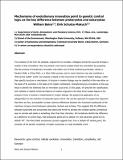Mechanisms of Evolutionary Innovation Point to Genetic Control Logic as the Key Difference Between Prokaryotes and Eukaryotes
Author(s)
Bains, William; Schulze-Makuch, Dirk
Download239_2015_9688_ReferencePDF.pdf (542.0Kb)
PUBLISHER_POLICY
Publisher Policy
Article is made available in accordance with the publisher's policy and may be subject to US copyright law. Please refer to the publisher's site for terms of use.
Terms of use
Metadata
Show full item recordAbstract
The evolution of life from the simplest, original form to complex, intelligent animal life occurred through a number of key innovations. Here we present a new tool to analyze these key innovations by proposing that the process of evolutionary innovation may follow one of three underlying processes, namely a Random Walk, a Critical Path, or a Many Paths process, and in some instances may also constitute a “Pull-up the Ladder” event. Our analysis is based on the occurrence of function in modern biology, rather than specific structure or mechanism. A function in modern biology may be classified in this way either on the basis of its evolution or the basis of its modern mechanism. Characterizing key innovations in this way helps identify the likelihood that an innovation could arise. In this paper, we describe the classification, and methods to classify functional features of modern organisms into these three classes based on the analysis of how a function is implemented in modern biology. We present the application of our categorization to the evolution of eukaryotic gene control. We use this approach to support the argument that there are few, and possibly no basic chemical differences between the functional constituents of the machinery of gene control between eukaryotes, bacteria and archaea. This suggests that the difference between eukaryotes and prokaryotes that allows the former to develop the complex genetic architecture seen in animals and plants is something other than their chemistry. We tentatively identify the difference as a difference in control logic, that prokaryotic genes are by default ‘on’ and eukaryotic genes are by default ‘off.’ The Many Paths evolutionary process suggests that, from a ‘default off’ starting point, the evolution of the genetic complexity of higher eukaryotes is a high probability event.
Date issued
2015-07Department
Massachusetts Institute of Technology. Department of Earth, Atmospheric, and Planetary SciencesJournal
Journal of Molecular Evolution
Publisher
Springer US
Citation
Bains, William, and Dirk Schulze-Makuch. “Mechanisms of Evolutionary Innovation Point to Genetic Control Logic as the Key Difference Between Prokaryotes and Eukaryotes.” Journal of Molecular Evolution 81.1–2 (2015): 34–53.
Version: Author's final manuscript
ISSN
0022-2844
1432-1432